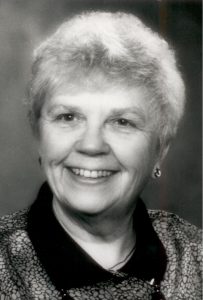
Formal Portrait of the Director
(1928-2021)
Marilyn Dawn Willman was born in Hancock, Michigan on December 31st, 1928. Her father was an engineer, and the family moved often within Michigan during her childhood as a result of his job. After completing her high school education in Cadillac, Michigan, she obtained her BScN from the University of Michigan, Ann Arbor in 1952, and went on to obtain her Master’s degree in 1959 from the University of Texas Medical Branch and her Doctorate in Educational Psychology in 1961 from the University of Texas at Austin. She then joined the faculty of the University of Texas Austin School of Nursing, progressing through the ranks to become Dean and then ultimately President of the University of Texas Nursing School (System-Wide) – a network of nursing education that was a precursor to the current independent nursing schools across the University of Texas state university system. In the role of President, she initiated the development of four new nursing programs, expanding the state-wide system from two to six campuses (Austin, El Paso, Fort Worth, Galveston, Houston, and San Antonio). A plaque on the exterior of the current University of Texas at Austin Faculty of Nursing Building placed in 1971 commemorates her as a member of that State School system’s Board of Regents.
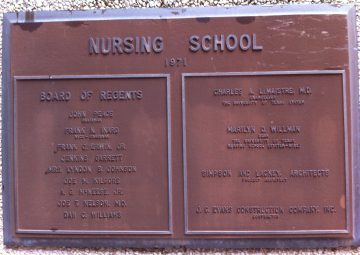
Cornerstone plaque on the University of Texas at Austin Faculty of Nursing Building commemorating the Board of Regents of the System Nursing School (1971).
In 1973, as an established nursing leader in the US, she became one of the Charter Fellows of the American Academy of Nursing.
Dr. Willman (as she was always known to students and junior faculty) arrived at UBC School of Nursing in 1977 to take up the position of Professor and Director – a position she held until her (mandatory) retirement in 1993. A strong champion of the need for a highly educated nursing workforce, Dr. Willman was intrigued by the challenge of a new country and health care system. She was also ready to take some distance from the Texas nursing school system which had by that time become somewhat embroiled in political dissent, resulting in a 1976 vote to dismantle the state school system, place each school under the administration of the president of the health science center or academic institution nearest it, and eliminate the position of President. On arrival, she recognized that the UBC School of Nursing had challenges of its own, not the least of which was that its ‘laddered’ program – designed to allow students to exit with an RN diploma after two years of study or continue for two more years to complete a BSN degree – was compressing too much material into the first two years without adequate time for consolidation. Students and faculty were exhausted, and the Registered Nurses of BC (the provincial regulatory body at that time) had raised alarm bells in its recent approval review. A proponent of a flat hierarchical structure with widely distributed decisional authority, Dr. Willman deleted the two assistant director positions and led the development of a full caucus of all faculty as the School’s primary decision-making body, establishing a set of standing committees to deal with major concerns. It was the newly formed curriculum committee that developed the framework for the new four-year curriculum which, after approval by the faculty caucus and Senate, was launched beginning in the 1979-80 academic year.
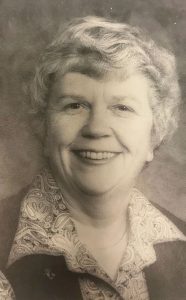
Marilyn Willman about the time of arrival to UBC.
The 1970s and 80s were a time of great change in society and health care. During the “Willman years,” the School was beginning to respond to the call of the 1974 Lalonde Report – a Canadian call for more attention to the role of lifestyle in health and prevention of illness. It was also attentive to the primary health challenge set out in the World Health Organization’s 1978 Alma Ata declaration of “health for all by the year 2000.” In 1984, the Canada Health Act was revised to ensure that Canadians had access to services beyond basic medical services. These ideas of personal responsibility with respect to health and promoting equity in relation to access to the resources to support health became enduring themes within the UBC Nursing curriculum.
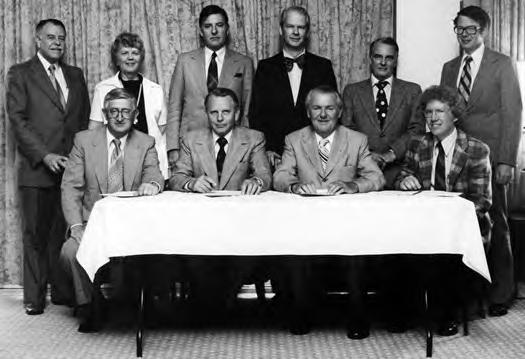
1979 Group Photo at Children’s Hospital/UBC Affiliation Agreement signing ceremony:
Left to right (standing): Faculty of Pharmacy Dean Bernie E. Riedel, School of Nursing Director Marilyn D. Willman, Pediatrics Department Head Robert H. Hill, Faculty of Medicine Associate Dean, Research & Planning David F. Hardwick, J. Shortt, Faculty of Medicine Dean William. A. Webber. Seated – UBC President Douglas T. Kenny, UBC Chancellor Leslie R. Peterson, G. Tullidge, T. Tegenfeldt. (source, UBC library)
The UBC School of Nursing had had a longstanding relationship with the Vancouver General School of Nursing, and much was changing with respect to the control and administration of hospital schools across the country. A widely publicized 1978 controversy with respect to the place of nursing within the VGH administration led to an administrative revision, but the challenges continued. Over the next decade, the dialogue continued and in 1989 the decision was taken to integrate the faculty and students of the VGH Hospital School of Nursing into a collaborative program with UBC, effectively doubling the size of the UBC Nursing undergraduate program. Another major innovation during the Willman years was instituting a “nursing outreach” program, through which diploma-prepared nurses around the province could complete an innovative baccalaureate degree supported by live lectures televised by Knowledge Network lectures followed by an interactive phone-in session, which reflected advanced use of learning technologies for their time. Although UBC had a longstanding tradition of continuing education, including a “post-RN” program allowing diploma-prepared nurses to enter into the third year of the UBC BSN program, the outreach program that was approved for the 1982-93 academic year and developed over the next decade took the university beyond the campus. It also allowed more flexibility for the on-campus students as it afforded opportunities to spread coursework over the summer or to take advantage of clinical facilitators beyond the Lower Mainland. By 1991, it was possible for BC RNs to complete the full degree through independent study.
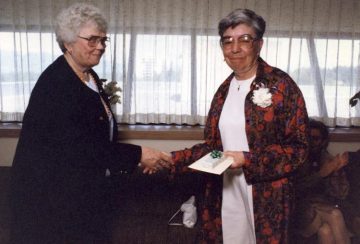 Dr. Willman congratulating well known faculty member Sheila Stanton on the occasion of her retirement in 1990. |
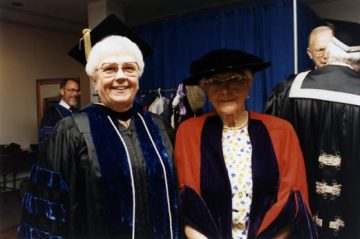 Dr. Willman with Lyle Creelman on the occasion of her honorary degree 1992. |
In 1980, the School of Nursing moved from a patchwork of locations on campus, including a number of former army huts and frat houses, into the newly constructed Walter Koerner Acute Care Unit, part of the UBC Health Sciences Centre on campus. This allowed for the co-location of all School faculty for the first time and added some new challenges, such as which of the faculty would be assigned offices with windows. Some members of the School were disappointed by this move, feeling that the School ought to have held out for its own new building; clearly, Dr. Willman’s prediction was correct, as that new building was not approved, as it turned out, for another 40 years.
During her 17-year tenure, Dr. Willman also strongly supported the development of nursing research strength, including PhD completion for many of the existing tenure track faculty as well as the recruitment of excellent new doctorally-educated nursing professors.
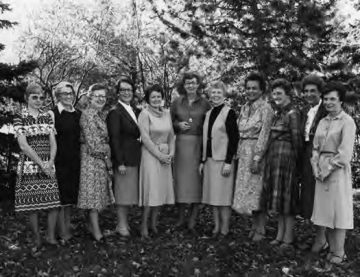
1980 Western Nursing Research Consortium Colleagues in Edmonton
Left to right: Amy Zelmer, Margaret Scott Wright, Dorothy Kergin, Shirley Stinson, Janet Kerr, Mavis Kyle, Marilyn Willman, Una Ridley, Peggy-Anne Field, Helen Glass, unknown.
She also worked to develop funding options for faculty, and smaller internal grants to allow them to compete for external funds, a Research Unit to provide them with administrative support, and an annual UBC Nursing Research Day, to which nurses were invited to hear presentations by UBC faculty and graduate students. She supported the establishment of a nursing honour society in 1990, later to become the Xi Eta Chapter of Sigma Theta Tau International. These developments set the stage for considering the idea of a UBC PhD program, toward which a committee was established in 1983. Despite challenges in securing Senate approval, the UBC School of Nursing was ultimately successful, and in September of 1991 launched Canada’s second PhD program in nursing (the University of Alberta had begun admitting students six months prior, although their program was not formally approved until some time later). The format of that PhD program, including a relatively small number of core disciplinary and philosophy of science courses and emphasizing research training and mentorship, became the model for Canadian doctoral nursing education over time.
Dr. Willman retired in December 1993 to live a quiet life in Richmond BC [photo 8 – retirement ]. She looked forward to annual vacations with her sister and brother-in-law in Michigan and became an avid collector of various dolls and artifacts.
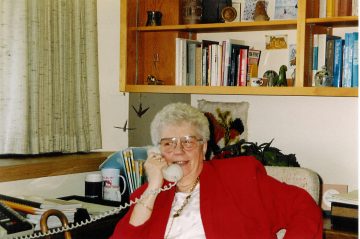
Dr. Willman at the time of her retirement, December 1993.
From the time of her retirement, she politely refrained from attending any formal School of Nursing events, although she did remain in contact with a few of her former School of Nursing colleagues and was always interested in catching up on the latest news, especially of developments in the lives of the younger faculty she had mentored. During the time of Sally Thorne’s Directorship, she agreed to serve as co-editor for the School’s newsletter TouchPoints, lending her famous eagle eye to each edition before it was put to print. In time, her declining health required relocation to a care facility in Richmond. In 2015, Dean Alexa Stuifbergen of the University of Texas at Austin Faculty of Nursing reached out to Dr. Willman via UBC colleagues to inquire if she might be well enough to travel to Texas as an invited guest to attend an event being held with respect to “a proposed endowment that is being established by Dr. Mary Walker, and named for Dr. Marilyn Willman in recognition of her contributions as former dean and president of The University of Texas System School of Nursing. Distributions from this endowment will be used to support students engaged in doctoral study at the University of Texas at Austin School of Nursing.” Dr. Willman was clearly delighted by the gesture and asked that the following message be conveyed back to Dean Stuifbergen. “Thank you to the School of Nursing for the recognition of my efforts on behalf of Nursing. I appreciate the honour that has been bestowed on me.”
Marilyn D. Willman, Professor Emerita and former Director of the UBC School of Nursing, died on May 20, 2021. Her sister and brother-in-law had predeceased her. Her enormous contributions to shaping the UBC School of Nursing we know today constitute a major chapter in the School’s illustrious history.
Reflections on the Life of Marilyn D. Willman
Thank you so much for the information about Marilyn Willman. She was a force in the School of Nursing and is largely responsible for me deciding to teach at UBC rather than returning to Community Health when I completed my MSN. This was definitely a career change that I never regretted and greatly appreciated. Teaching at UBC and all the opportunities it provided (including friendships) was a wonderful decision for me.
Roberta Hewat, Associate Professor Emerita
Dr. Willman was the director for much of my period of SoN Faculty membership. I remember her well, in a very positive way.
Donelda Ellis Parker, Associate Professor Emerita
I would like to add my grateful voice to the tributes being paid to Dr. Willman. When Dr. Willman set the stage for considering the idea of a UBC School of Nursing PhD program, her success had an immediate and profound effect on my career. Together with Rosalie Starzomski (now Dr. Rosalie Starzomski, Professor at the University of Victoria School of Nursing), in September of 1991, I became one of the first two students in Canada’s second PhD program in nursing. This program was launched by Dr. Willman and was well-supported by diverse expert nursing faculty in the UBC School of Nursing. As Dr. Thorne’s tribute to Dr. Willman indicates, the format of that PhD program included a relatively small number of core disciplinary and philosophy of science courses and emphasized research training and mentorship. It became the model for Canadian doctoral nursing education over time–a wonderful legacy for those of us who completed our PhD in Nursing at UBC, and for doctoral-level nursing education across Canada.
Patricia (Paddy) Rodney, Associate Professor Emerita
Having started in the school in 1988, Marilyn was my first director (and yes you would never have called her anything but Dr. Willman) – a different era and time. But also a choice I think she clearly made. She was boss, and you clearly knew that. Yet, she could be warm and always seemed to have the pulse on what was happening in the school and with her faculty. I so remember those yearly check-ins. The pictures are great especially the one with her at her desk…that is how I remember her. She had a good sense of humor, with a twinkle in her eye and a genuine smile. I remember her with great respect and appreciation.
I was sad to see that she outlived her sister and brother-in-law. I would from time to time see Marilyn in Richmond, in those early days with (former School of Nursing colleague) Sylvia Holmes. Later I wound meet her in the grocery store (IGA Richmond). She would stop to chat, always asked how I was and what was happening at the School. She was fiercely private and determinedly independent.
Good memories…
Lynne Esson, Longtime School of Nursing Lecturer, and BC nurse historian
I first met Marilyn when I was in the MSN program and she met with grad students as part of the interview process (for her position as Director). I found her engaging and genuinely interested in us as students. When she began as Director, I had just joined faculty as an Instructor II. There was a large meeting in IRC to hear the outcomes of the recent RNABC program review (the recurrent theme of “not enough clinical time” was a focus); this was the two-plus-two curriculum. I recall her stepping to the podium and opening by saying “why didn’t y’all tell me about this when I was here before?”
Marilyn was a well-organized administrator. In the early part of her directorship, Faculty Caucus was born along with a committee structure focused on key areas involving curriculum development/implementation, policy, and faculty development. The nursing research mandate evolved, as did the School’s profile within BC and, nationally, via CAUSN. The School also moved to its premises in the Koerner Pavilion, achieving the goal of having all faculty under the same roof, rather than scattered across campus. This was the era of the nursing model, behavioural objectives, massive clinical evaluation tools, performance testing, and the concept-based curriculum. The MSN program focused on core knowledge and on the functional areas of teaching, administration, and clinical specialization. The doctoral program was also developed and actualized. A lot occurred during her time at the helm!
On a personal note, I recall that Marilyn’s door was always open and she was always ready and willing to chat about issues facing the School or me as an individual. She always appreciated candour, even if the message wasn’t necessarily a positive one, especially if you came with a solution already thought out! She wasn’t tempestuous or egotistical but genuinely cared about the School and its people. She did not appoint associate directors but relied on Year Coordinators to implement the program and the attendant policies and procedures. She had good relationships with fellow directors and deans across campus. She had an amazing memory for details of all kinds and was an editor and proofreader par excellence. She was straightforward, concise, and supportive – a somewhat quiet leader steeped in traditional values. And she loved musical theatre, references to which continued to pop up on occasion even after her retirement.
Carol Jillings, Associate Professor Emerita
Dr. Willman was a fascinating figure to me. I arrived at the School as a post-RN BSN student in 1977, the year she began her Directorship. My earliest memories of her are from Marion Woodward Lectures, one in particular in which she wore audacious orange shoes. In 1979, she hired me as a Lecturer, encouraged my MSN completion, and launched me on my academic career. So my recollections are of the strong personal interest she took in young faculty and potential young faculty, in supporting careers and, for many of us, creating the conditions under which we could complete PhDs (which were not at that time available in nursing in Canada). Dr. Willman’s term as Director was not without conflict. The School community included strong and opinionated senior faculty members, many of whom did not always see eye-to-eye with her strategic priorities. I think she had come from a contentious academic climate in Texas and would have preferred a state of calm. But she guided us through the massive university budget cuts of the mid-1980s, ensuring that none of us pre-tenured faculty lost our positions, and among those whom she brought into the School over those years were faculty who would become nationally and internationally recognized scholars and leaders. Mandatory retirement brought her time on faculty to a close, and she had to reinvent herself. Carol Jillings and I maintained an annual lunch date with her for many years and were intrigued with how beloved she had become to restauranteurs in her local area of Richmond, and how well-informed she remained about the successes and personal lives of her former colleagues. When her capacity declined and made independent living difficult, she reacted in her typical practical style to sign over her financial affairs to a legal representative and move into a care facility of her own choosing. And there, despite a much more narrow world than she once enjoyed, she was still happily interviewing fellow residents and maintaining a keen interest in their lives. She was an old-style leader and a complicated personality, but one I will always remember with deep fondness.
Sally Thorne, Professor
As a graduate student and a sessional lecturer in the 1980s, I have positive memories of my association with Dr. Willman as we called her at that time. I benefitted greatly from her role on my MSN thesis committee. She took an interest in my topic (public health nursing history), asked astute questions, and provided gentle guidance throughout the process. After her retirement, she invited me to serve on the Bursary Selection Committee of the Registered Nurses Foundation. I remember her skill at chairing the meetings and the enjoyable experience of reconnecting with her once a year when I felt comfortable at last to call her Marilyn.
Nora Whyte, Former Adjunct Professor and longtime friend of the School of Nursing
The BC History of Nursing Society houses a record of various documents pertaining to Dr. Willman’s Directorship. https://bcnursinghistory.ca/dvteam/willman-marilyn-dawn-1928/
UBC Library Open Collections houses digital versions of the School newsletters (search term “Nursing Today”) published throughout Dr. Willman’s Directorship.
A detailed description of events in the School of Nursing over the course of Dr. Willman’s Directorship is available in Legacy: History of Nursing Education at the University of British Columbia 1919-1994 (Glennis Zilm & Ethel Warbinek, 1994, UBC Press).